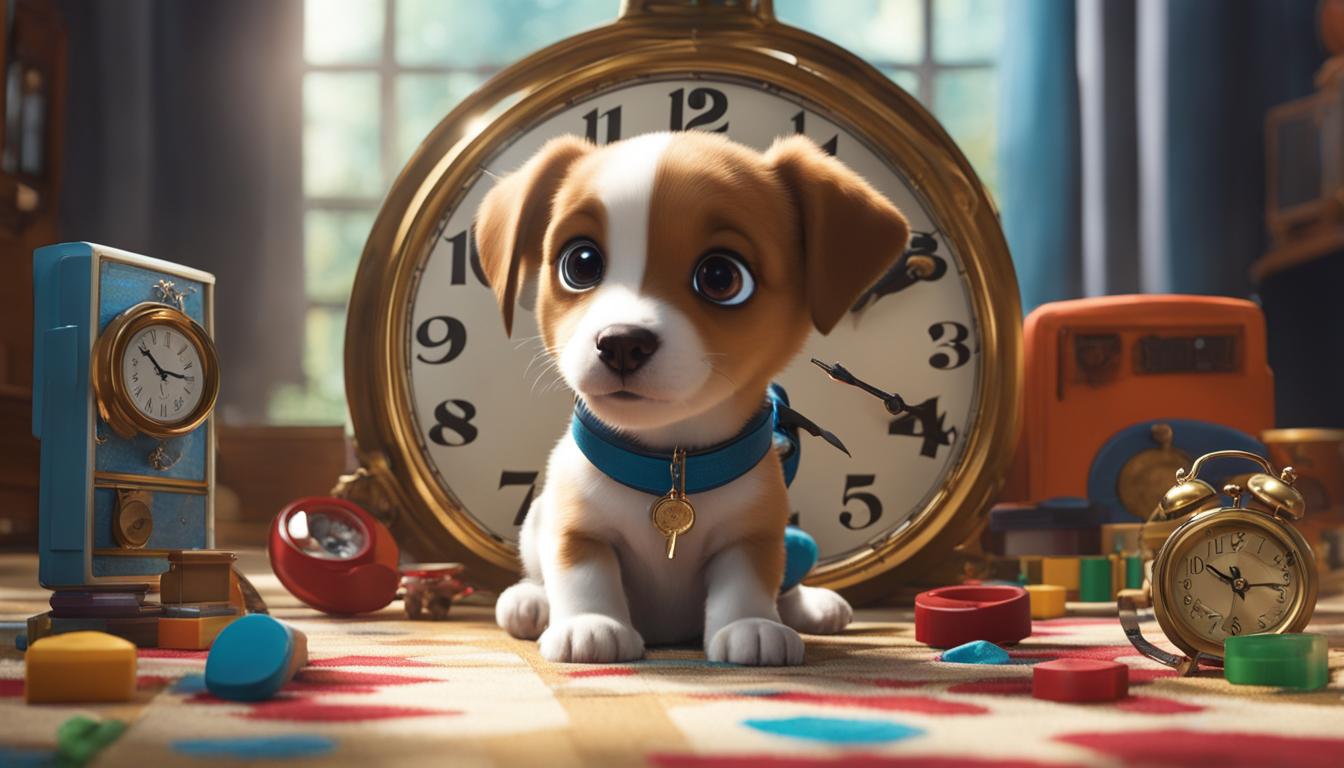Welcome to our guide on when to train a puppy for the best results. Training is a crucial part of a puppy’s development and sets the foundation for their behavior as adult dogs. By starting training at the right age and following a consistent schedule, you can ensure that your puppy grows into a well-behaved and obedient companion.
So, when is the best time to start training your puppy? Ideally, you should begin training as soon as you bring them home, typically around 8 weeks old. However, before diving into training sessions, it’s important to focus on building an emotional bond and creating a safe environment for your puppy. This will help establish trust and set the stage for successful training.
During the growth stage between 8-16 weeks, puppies should be exposed to their environment and learn impulse control through basic behaviors like sitting. This critical period is known as the socialization period, where puppies should be introduced to various stimuli and taught that the world is a safe place.
By the time your puppy reaches 6 months old, they should have learned important behaviors such as polite play, housetraining, being alone, recall, and continued impulse control. These milestones are essential for their overall development and will pave the way for more advanced training in the future.
- The Importance of Early Training for Puppies
- Creating a Positive Training Environment
- Training Goals for Puppies: 8-16 Weeks
- Training Goals for Puppies: By 6 Months
- Training Goals for Puppies: By One Year
- Training Puppies of Any Age
- The Benefits of Positive Reinforcement Training
- Training Tips for Puppy Parents
- Training Milestones for Puppies: 8-16 Weeks
- Conclusion
- FAQ
- Source Links
Key Takeaways:
- Start training your puppy as soon as you bring them home, around 8 weeks old.
- Building an emotional bond and creating a safe environment is crucial before beginning training.
- Expose your puppy to their environment and teach impulse control during the crucial growth stage between 8-16 weeks.
- By 6 months old, your puppy should have learned polite play, housetraining, being alone, recall, and continued impulse control.
- Training is an ongoing process, and consistency is key to achieving optimal results.
The Importance of Early Training for Puppies
Early training for puppies is crucial for their development and behavior as adult dogs. The first few months of a puppy’s life are a critical socialization period that ends by 16 weeks. During this time, it is essential to expose them to their environment and teach them that the world is a safe place. This period is often referred to as the puppy socialization timeline.
One of the primary goals of early training is to teach puppies basic impulse control. This can be achieved through simple behaviors like sitting. Impulse control is essential as it helps puppies learn to manage their actions and make better choices. Teaching puppies to sit and wait before getting their food or going outside, for example, helps them develop self-control and patience.
Along with impulse control, early training should also focus on teaching puppies polite behaviors like housetraining, polite play, and how to be alone for short periods of time. These skills lay the foundation for future obedience and good behavior. By starting training early, you can shape your puppy’s behavior and set them up for a lifetime of successful learning.
The Benefits of Early Training
“Early training is like laying the groundwork for a well-behaved and balanced dog. It helps puppies develop confidence, learn impulse control, and build positive associations with their environment,” says Dr. Sarah Thompson, a canine behavior specialist.
Early training not only helps puppies develop crucial life skills, but it also strengthens the bond between the puppy and their owner. Training sessions provide an opportunity for positive interactions and communication, fostering trust and understanding. Additionally, early training sets clear boundaries and establishes leadership, which is essential for a harmonious relationship with the puppy.
By starting training early and focusing on the puppy socialization timeline, you can give your puppy the best possible start in life. Remember to be patient, consistent, and use positive reinforcement techniques to make training enjoyable for both you and your furry friend.
Creating a Positive Training Environment
Before starting training, it is important to create a positive environment for your puppy. Building a loving and trusting bond plays a crucial role in successful training. Positive-reinforcement training is recommended, using treats or toys as rewards. Training sessions should be kept short and fun, with 5-minute sessions a few times a day. Consistency in training cues and rewards is key. Patience is necessary, as puppies are learning and may make mistakes. Practice training in different environments to help your puppy generalize the learned behaviors.
Importance of a Positive Environment
Creating a positive training environment is essential for the success of your puppy’s training. When your puppy feels comfortable and loved, they are more likely to respond positively to your training efforts. Building a loving and trusting bond from the start sets the foundation for a strong relationship and effective training.
Using Positive Reinforcement
Positive-reinforcement training is a highly effective method for training puppies. It involves rewarding desired behaviors with treats, toys, or praise. This positive association helps your puppy understand what behaviors are desired and encourages them to repeat those behaviors. Avoid using punishment or dominance-based techniques, as they can lead to fear and anxiety in your puppy.

Consistency and Patience
Consistency is key in training your puppy. Use the same cues and rewards consistently to help your puppy understand what is expected of them. Additionally, be patient with your puppy as they are learning. Puppies may make mistakes, and it is important to remain calm and patient throughout the training process.
Generalizing Behaviors
To ensure that your puppy’s training is effective in various situations, it is important to practice training in different environments. This helps your puppy generalize the behaviors they have learned and apply them in different contexts. Gradually introduce distractions during training sessions to help your puppy learn to focus and obey commands even in challenging situations.
Training Goals for Puppies: 8-16 Weeks
During the crucial 8-16 week period, puppies should focus on two primary training goals: exposure to the environment and impulse control. It is important to introduce them to various surroundings, noises, and activities to help them become familiar and comfortable with their surroundings. This exposure should include traffic noises, public transportation, and interactions with other dogs. The goal is to teach puppies that the world is not a scary place and to help them develop confidence.
Impulse control is another important aspect of training during this stage. Puppies can begin learning basic behaviors like sitting, which not only helps with impulse control but also sets a foundation for obedience training. Teaching them to sit and wait for their food or treats helps instill patience and self-control. This allows them to develop good manners and prevents impulsive behaviors that may lead to problems in the future.
| Training Goals | Description |
|---|---|
| Exposure to the environment | Introduce puppies to various surroundings, noises, and activities to help them become familiar and comfortable with their environment. |
| Impulse control | Teach puppies basic behaviors like sitting to help them develop patience and self-control, laying the foundation for future training. |
By focusing on these training goals during the 8-16 week period, puppy owners can set their furry companions up for success in the future. A solid foundation of exposure to the environment and impulse control will not only help puppies become well-behaved adult dogs but also instill confidence and a positive association with their surroundings.
Training Goals for Puppies: By 6 Months
By the time your puppy reaches 6 months old, they should have achieved several important training goals. These goals include mastering polite play, housetraining, being alone for short periods, recall, continued impulse control, and the mastery of basic behaviors. It is during this stage of training that your puppy will start to develop into a well-behaved and obedient adult dog. Let’s take a closer look at each of these goals:
| Training Goals | Description |
|---|---|
| Polite Play | Teach your puppy to stop and follow the “drop it” command during playtime to prevent possessiveness and encourage good social behavior. |
| Housetraining | Maintain steady progress in teaching your puppy to go potty in appropriate places and reinforce the desired behavior with positive reinforcement. |
| Being Alone | Help your puppy develop the ability to tolerate being alone for short periods by gradually increasing the duration of separation and rewarding calm behavior. |
| Recall | Teach your puppy to come when called, using positive reinforcement and gradually increasing distractions to ensure a reliable recall. |
| Continued Impulse Control | Build on the basic impulse control skills learned earlier by introducing more challenging situations and distractions. |
| Mastery of Basic Behaviors | Ensure your puppy has mastered basic commands such as sit, stay, down, and leave it, laying the foundation for further training. |
Remember, every puppy is unique and may progress at their own pace. Some puppies may achieve these goals quicker than others. Patience, consistency, and positive reinforcement are key to successful training at this stage.
Continue to create a positive training environment and reinforce good behavior as your puppy grows. By working towards these goals, you’ll set your puppy up for a lifetime of well-behaved companionship.
Training Goals for Puppies: By One Year
By the time your puppy reaches one year old, they should have made significant progress in learning all the polite behaviors they will need for the rest of their lives. While the specific behaviors may vary based on the individual dog and environment, there are several key milestones to focus on during this stage of training.
One important goal is teaching your puppy to walk on a loose leash. This means they should be able to walk beside you without pulling or tugging on the leash. By practicing consistent leash manners, you can ensure enjoyable and stress-free walks for both you and your furry friend.
Another crucial milestone is teaching your puppy to stay calm during distractions. This includes remaining focused and composed in busy environments, when encountering other dogs, or when there are loud noises. By introducing controlled distractions during training sessions, you can help your puppy develop the self-control needed to stay calm in various situations.

Last but not least, it’s essential to work on teaching your puppy polite greetings with other dogs and people. This involves teaching them not to jump up on people or rush towards other dogs. By enforcing consistent boundaries and using positive reinforcement, you can help your puppy develop good manners and create positive interactions with others.
| Training Goals for Puppies: By One Year | Description |
|---|---|
| Walk on a Loose Leash | Teach your puppy to walk alongside you without pulling or tugging on the leash. |
| Stay Calm During Distractions | Help your puppy develop the self-control to remain calm in busy or distracting environments. |
| Polite Greetings | Teach your puppy to greet other dogs and people politely, without jumping up or rushing towards them. |
By focusing on these training goals, you can help your puppy develop into a well-behaved and confident adult dog. Remember, consistency, positive reinforcement, and patience are key to successful training.
Training Puppies of Any Age
Whether you have a young puppy or an older dog, it’s never too late to start training. While it is ideal to begin training in puppyhood, older dogs can still learn new behaviors with patience and positive reinforcement training. Building an emotional foundation based on trust and clear communication is crucial, especially for dogs that have had negative experiences or are fearful.
Positive reinforcement training is recommended for dogs of any age. This method involves using rewards, such as treats or praise, to encourage desired behaviors. Punishment and dominance-based techniques should be avoided, as they can lead to fear and anxiety in adult dogs. With positive reinforcement training, you can teach dogs of any age polite behaviors and reverse rude behaviors by providing enjoyable alternatives.
When training an older dog, it may take more time and patience to see progress. It’s important to set realistic expectations and understand that every dog learns at their own pace. Consistency in training cues and routines is key to effective learning. Practice training in different environments to help your dog generalize the behaviors they have learned.
In summary, while starting training in puppyhood is ideal, dogs of any age can still learn new behaviors. Positive reinforcement training, patience, and consistency are essential to the training process. By building a loving and trusting bond with your dog, you can help them develop positive associations with training and create a happy, well-behaved companion.
The Benefits of Positive Reinforcement Training
Positive reinforcement training is widely regarded as the most effective and humane method for training puppies. It involves using rewards, such as treats, praise, or play, to encourage and reinforce desired behaviors. This training technique focuses on rewarding good behavior rather than punishing unwanted behavior, creating a positive association with training and building a strong bond between you and your puppy.
Using positive reinforcement training methods has numerous benefits. First and foremost, it helps create a positive and enjoyable learning experience for your puppy. By using rewards that your puppy finds motivating, such as their favorite treats, you can make training sessions fun and engaging. This not only increases their willingness to learn but also strengthens the bond between you and your puppy.
Positive reinforcement training also promotes the development of good behavior and helps prevent behavioral problems. By rewarding your puppy for behaviors you want to encourage, such as sitting, coming when called, or walking nicely on a leash, you are teaching them what you expect from them. This consistency and positive feedback help them understand the desired behaviors and make them more likely to repeat them in the future.
| Benefits of Positive Reinforcement Training |
|---|
| Creates a positive and enjoyable learning experience |
| Strengthens the bond between you and your puppy |
| Promotes the development of good behavior |
| Helps prevent behavioral problems |
In contrast, punishment-based training methods, such as corrections or dominance-based techniques, can have negative consequences. These methods can lead to fear, anxiety, and a breakdown of trust between you and your puppy. They may also result in unwanted side effects, such as aggression or avoidance behaviors.
Remember, positive reinforcement training is about teaching your puppy what to do, rather than focusing on what not to do. By rewarding the behaviors you want to see, you are setting your puppy up for success and encouraging a lifetime of good behavior. So, grab some treats, a clicker if you’d like, and get ready to have fun training your puppy using positive reinforcement!
Training Tips for Puppy Parents
Training a puppy can be a fun and rewarding experience, but it can also have its challenges. Here are some important tips to help you effectively train your furry friend:
- Use positive reinforcement: Positive reinforcement is a powerful tool in puppy training. Reward your puppy with treats, praise, and affection when they exhibit the desired behavior. This will motivate them to repeat the behavior and strengthen the bond between you and your puppy.
- Keep training sessions short: Puppies have short attention spans, so it’s important to keep training sessions brief. Aim for 5-minute sessions a few times a day. This will help maintain your puppy’s focus and prevent them from becoming bored or frustrated.
- Be consistent: Consistency is key in puppy training. Use the same cues and rewards each time you train your puppy. This will help them understand what is expected of them and make the learning process easier.
- Practice in different environments: Training your puppy in different environments will help them generalize the behaviors they have learned. Start training in a quiet, familiar setting and gradually introduce more distractions. This will teach your puppy to listen and respond to your commands in various situations.
Remember, every puppy is unique and will learn at their own pace. Be patient, understanding, and always use positive reinforcement. With time and consistency, your puppy will become a well-behaved and obedient companion.
Testimonial:
“I followed these training tips with my new puppy, and I couldn’t be happier with the results. Positive reinforcement has made our training sessions enjoyable, and my puppy quickly learned the basic commands. Consistency and short training sessions have helped maintain his attention and focus. Training in different environments has made him more adaptable and responsive to my cues. I highly recommend these tips to all puppy parents!”

| Training Tip | Description |
|---|---|
| Positive Reinforcement | Use treats, praise, and affection to reward desired behaviors. |
| Short Training Sessions | Keep training sessions brief to maintain your puppy’s focus. |
| Consistency | Use the same cues and rewards to create a clear understanding of expectations. |
| Practice in Different Environments | Expose your puppy to different settings to generalize their learned behaviors. |
Training Milestones for Puppies: 8-16 Weeks
Between 8-16 weeks old, puppies should achieve several important training milestones. It is during this crucial period that they begin to form impressions about their environment and learn vital socialization skills. Exposure to various sights, sounds, and experiences helps puppies become familiar and comfortable with their surroundings, enabling them to navigate the world with confidence.
One of the primary goals during this stage is teaching basic impulse control. Puppies should learn to sit on command, which helps them develop self-control and focus. This simple behavior sets the foundation for future obedience training and establishes good manners.
Additionally, this is an opportune time to introduce your puppy to other dogs, people, and different environments. Gradual exposure and positive experiences will help them build positive associations and develop appropriate social skills. It’s important to remember that each puppy learns at their own pace, so be patient and provide consistent training to support their growth and development.

Conclusion
In conclusion, training puppies is a crucial part of their development and sets the foundation for their behavior as adult dogs. Starting training as soon as they are brought home, typically around 8 weeks old, is recommended. Building a positive training environment based on trust and clear communication is essential for successful training.
During the growth stage between 8-16 weeks, puppies should focus on exposure to their environment and learning impulse control. Basic behaviors like sitting can be taught to establish good manners and self-control. By 6 months old, puppies should have achieved important milestones such as polite play, housetraining, recall, and continued impulse control. By one year old, they should have mastered basic behaviors, providing a solid foundation for further training.
Positive reinforcement training is the preferred method, using rewards like treats or praise to encourage desired behaviors. Avoiding punishment and dominance-based techniques is important to prevent fear and anxiety in adult dogs. Patience, consistency, and practicing training in different environments are key to successful training. Remember that puppies learn at different speeds, so it’s important to be patient and understanding throughout the process.
FAQ
When should I start training my puppy?
Puppies should start training as soon as they are brought home, typically around 8 weeks old.
What is the importance of early training for puppies?
Early training is crucial for the development and behavior of adult dogs. It helps puppies learn impulse control, socialize with their environment, and build a foundation for future good behavior.
How can I create a positive training environment for my puppy?
Building an emotional bond and creating a safe environment are important before beginning training. Use positive reinforcement training, keep sessions short and fun, and be consistent in cues and rewards.
What are the training goals for puppies between 8-16 weeks?
The primary training goals during this period are exposure to the environment and impulse control. Puppies should be exposed to different surroundings and learn basic behaviors like sitting.
What are the training goals for puppies by 6 months?
By 6 months old, puppies should have achieved milestones like polite play, housetraining, being alone, recall, continued impulse control, and mastery of basic behaviors.
What are the training goals for puppies by one year?
By one year old, puppies should have mastered basic behaviors and learned additional skills like loose-leash walking, staying calm during distractions, and polite greetings with other dogs and people.
Can I still train my puppy if they are older?
It is never too late to teach a dog new behaviors, but starting training in puppyhood is ideal. Building an emotional foundation based on trust and clear communication is more challenging if not established early on.
What are the benefits of positive reinforcement training?
Positive reinforcement training, using rewards like treats or praise, is the preferred method as it creates a positive association with training and builds a strong relationship between the owner and the puppy.
What are some training tips for puppy parents?
Use your puppy’s food as a reward during training sessions, keep sessions short and consistent, practice training in different environments, be patient, and understand that puppies learn at different speeds.
What are the training milestones for puppies between 8-16 weeks?
Puppies should become familiar with their surroundings and learn basic impulse control through behaviors like sitting. This period is critical for socialization and learning about the world around them.




